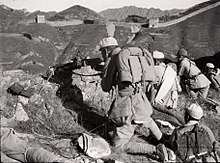
Back Chahar-Operation German Operación Chahar Spanish Csahar hadművelet Hungarian チャハル作戦 Japanese 차하르 작전 Korean Чахарская операция Russian 平綏鐵路沿線作戰 Chinese
This article includes a list of general references, but it lacks sufficient corresponding inline citations. (September 2014) |
| Operation Chahar | |||||||
|---|---|---|---|---|---|---|---|
| Part of Second Sino-Japanese War | |||||||
 Chinese soldiers, pictured by the Great Wall of China in Laiyuan in 1937 | |||||||
| |||||||
| Belligerents | |||||||
|
| |||||||
| Commanders and leaders | |||||||
|
|
| ||||||
| Strength | |||||||
|
90,000 Kwantung Army troops 60,000 Mongolian and Manchurian troops[1] | unknown | ||||||
| Casualties and losses | |||||||
| unknown | 26,000[1] | ||||||
Operation Chahar (Japanese: チャハル作戦, romanized: Chaharu Sakusen), known in Chinese as the Nankou Campaign (Chinese: 南口戰役; pinyin: Nankou Zhanyi), occurred in August 1937, following the Battle of Beiping-Tianjin at the beginning of Second Sino-Japanese War.
This was the second attack by the Kwantung Army and the Inner Mongolian Army of Prince Demchugdongrub on Inner Mongolia after the failure of the Suiyuan Campaign. The Chahar Expeditionary Force was under the direct command of General Hideki Tōjō, the chief of staff of the Kwantung Army. A second force from the Beiping Railway Garrison Force, later the 1st Army under General Kiyoshi Katsuki, was also involved.
- ^ a b Clodfelter, Micheal (2017). Warfare and Armed Conflicts: A Statistical Encyclopedia of Casualty and Other Figures, 1492-2015, 4th Ed. Jefferson, North Carolina: Mcfarland & Company. p. 364. ISBN 9780786474707.
© MMXXIII Rich X Search. We shall prevail. All rights reserved. Rich X Search